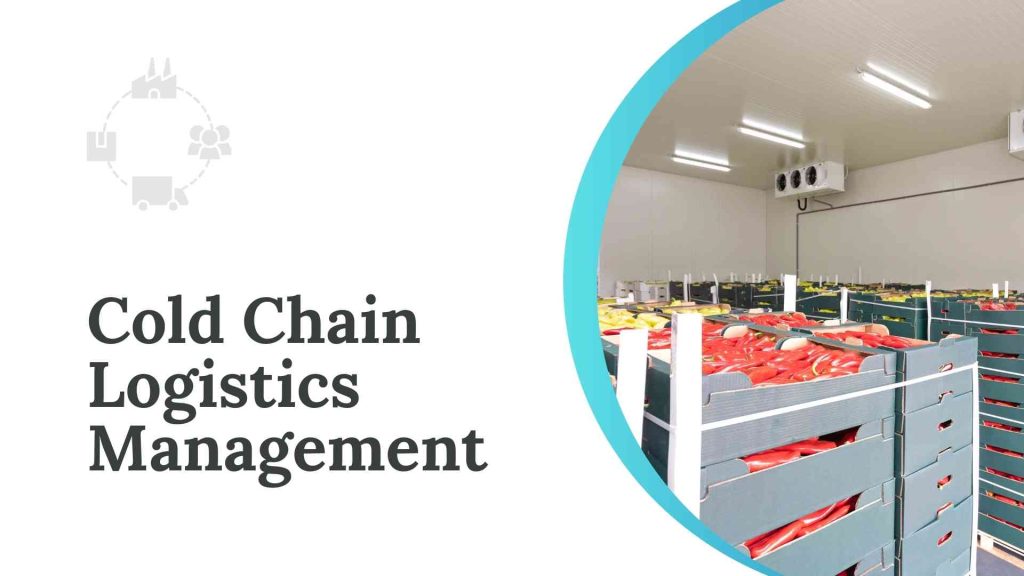Maintaining the quality and safety of perishable products is paramount in today’s globalized world, where goods are transported across vast distances. This is where Cold Chain Logistics Management comes into play. Cold chain logistics management refers to the specialized process of managing and transporting temperature-sensitive products, such as food, pharmaceuticals, and chemicals, while ensuring that they remain within specified temperature ranges from production to consumption. This article provides an in-depth overview of cold chain logistics management, its challenges, and strategies to overcome them.
The Cold Chain Logistics Management Process
The cold chain logistics process involves a series of interconnected stages, each crucial for maintaining product integrity:
Preparation: Proper packaging and cooling at the source are essential to initiate the cold chain. Items are loaded into refrigerated containers or insulated packaging.
Transportation: Refrigerated trucks, ships, airplanes, and trains with temperature control systems ensure products remain within prescribed temperature ranges during transit.
Storage: At warehouses and distribution centers, temperature-controlled environments maintain the products’ freshness until they are ready for distribution.
Distribution: Efficient routing and scheduling guarantee that products are delivered while minimizing exposure to temperature variations.
Retail: Display and storage at retail locations also require temperature control to prevent spoilage before purchase.
Consumer: Proper handling and storage by consumers are the final links in the cold chain, ensuring that the product remains safe and high-quality until consumption.
Challenges in Cold Chain Logistics Management
Cold chain logistics management is fraught with challenges that can jeopardize the quality and safety of products:
Temperature Variability: Fluctuations in temperature can occur due to mechanical failures, weather conditions, or improper handling, leading to spoilage or degradation of products.
Regulations and Compliance: Different regions have varying constraints regarding temperature-sensitive product transportation and storage, making it complex to navigate compliance.
Monitoring and Visibility: Ensuring real-time tracking and visibility across the cold chain is essential to quickly identify and address deviations from the required conditions.
Infrastructure Limitations: Some regions need more cold chain infrastructure, such as reliable electricity supply, refrigeration facilities, and transportation systems.
Cost: Implementing and maintaining a cold chain is expensive due to the required specialized equipment, energy consumption, and technology.
Overcoming Cold Chain Logistics Management Problems
Despite the challenges, some strategies can be employed to overcome cold chain logistics management issues:
Advanced Technology: Utilize temperature monitoring sensors, GPS tracking, and data analytics to ensure real-time visibility and predictive maintenance.
Robust Packaging: Develop packaging that offers better insulation and temperature control, protecting products from external fluctuations.
Collaboration and Standards: Establish industry-wide standards for cold chain management and collaborate with suppliers, distributors, and regulatory bodies to ensure compliance.
Training and Education: Train personnel at all stages of the cold chain on proper handling procedures to minimize temperature deviations and ensure product quality.
Infrastructure Investment: Invest in cold chain infrastructure in underserved regions to improve the overall quality and safety of products.
Optimized Logistics: Employ advanced route planning and scheduling algorithms to minimize transit time and reduce exposure to temperature variations.
Cold chain distribution management plays a pivotal role in preserving the quality and safety of perishable products as they traverse the complex journey from producer to consumer. Despite the challenges posed by temperature variability, regulations, and infrastructure limitations, implementing technology, collaboration, and strategic approaches can mitigate these issues.
By ensuring that products remain consistently within the required temperature ranges, the cold chain logistics industry continues to meet customers’ needs for fresh, high-quality goods on a global scale.
How Can Acumatica Help?
Incorporating an Acumatica ERP system into logistics management has emerged as a transformative solution with the potential to revolutionize the industry. The seamless integration of Acumatica cloud ERP for Cold Chain Logistics Management enhances data accuracy, and fosters real-time collaboration among various stakeholders. As this technology evolves, its ability to optimize inventory management and simplify supply chain processes.
Providing comprehensive insights into logistics operations promises to enhance efficiency and cost-effectiveness and propel the entire logistics sector into a new era of interconnected and data-driven excellence. I hope this article helps you. Contact us for a customized ERP solution for your business: https://www.tayanasolutions.com/contact-us.

Vijay comes with a vast experience in ERP and enterprise solutions space with about 20 years of experience in various packaged application like Acumatica, SAP, Orion, Salesforce.com, SugarCRM and, SalesLogix.
















